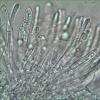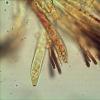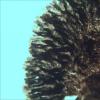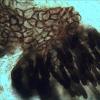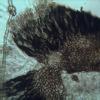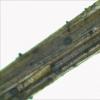
20-12-2025 23:08
Patrice TANCHAUDBonsoir, récolte sur sol sablonneux dans l'arri�

21-12-2025 09:32
Hello.A tiny ascomycete found embedded in wood in

20-12-2025 15:47
Mirek GrycHi.These grew on pine wood that was heavily covere

18-12-2025 21:17
Pol DebaenstThe identification took me to Byssonectria deformi

15-12-2025 07:09
 Danny Newman
Danny Newman
indet. Rutstroemiaceae sp. on unk. fallen leavesMc

19-12-2025 10:10
Patrice TANCHAUDBonjour, récolte réalisée en milieu dunaire, a

18-12-2025 17:23
 Bruno Coué
Bruno Coué
Bonjour,je serais heureux d'avoir votre avis sur c

Hello,
today I found a very minute Pyrenopeziza species on old stems of a Poaceae (possibly Nardus stricta or an Eleocharis spec.), in mountainous wet heath-land (1000 m a.s.l.).
Besides that I don't know any Pyrenopeziza on grass, this one had a strong red porus reaction.
The paraphyses are filled on approx. 1/3 of the length with small refractive guttules.
The spores are approx. 17 x 4 µm, with high oil content.
Anybody an idea on that?
thank you and best regards,
Andreas

Interessant! Aber ich glaube das ist keine Pyrenopeziza. Hat das denn angularis?
Hast du ein Makro? Wie ist der Apo-diam.?
Kann man am Querschnitt des Halms die Pflanze evtl. erkennen? ist der eckig?
Zotto

Hallo Zotto,
du hast recht, ich habe auch Zweifel an Pyrenopeziza. Das Excipulum war eher eine prismatica als eine angularis.
Die Apothecien sind winzig, etwa 300 µm Durchmesser, fast schwarz außen wie im Hymenium. So klein kann ich nicht fotografieren und ich habe keine Stereolupe mit Trinotubus hier.
Ich habe mir das Substrat nochmal angeschaut und bin nunmehr nicht mehr sicher, ob das nicht ein Blatt einer Poaceae ist statt eines Halmes. Dreieckig ganz bestimmt nicht, das wäre ja dann Carex. Am Standort gab es mit Sicherheit keine Carex. In Frage kommt eigentlich wirklich nur Nardus stricta oder ein Gras, das für mich wie eine Eleocharis aussieht (bin aber nicht sicher ....).
beste Grüße,
Andreas

Ein Makro kann auch schon nützlich sein, wenn man dadurch sieht, ob die Apos gesellig sitzen.
Vermutlich sind sie flach, oder ragt der Rand vor?
Ein Schnitt wäre noch gut, etwa ob was gelatinisiert ist.

Hallo Zotto,
ich versuche morgen früh noch etwas mehr Details zu bekommen.
Die Apothezien waren zwar flach, hatten aber doch einen erkennbaren Rand. Sie wuchsen sehr vereinzelt, und es warena uch nur wenige Apothezien.
Ich hoffe, es ist noch was intakt geblieben von der Kollektion.
beste Grüße,
Andreas

Hello,
so here I have some new pictures.
In the same collection, but obviousely another substrate, has been another mollisioid ascomycete, so the macroscopic description above might be comprise both. Here now the "Pyrenopeziza", which seems to be growing on Juncus??
The apothecia are truly mollisioid, flat with a distinct margin, greyish, the exterior nearly blackThe textura is a true angularis, the marginal hairs are typical for Pyrenopeziza/Pirottaea.
Spores are 14-17 x 3,5-4 µm, with an oil content of approx. 4,5.
the mollisioid fungus follows in another thread later.

Quelques photograps des ascques et paraphyses?
Zotto

Hallo Zotto,
oben im Eingangsbeitrag sind fotos von Asci und Paraphysen.
Ceijpia hystrix könnte gut sein, die hatte ich noch nie. Monilia ist nicht ausgeschlossen aufgrund der Ökologie, bewusst gesehen habe ich aber keine.
besten Dank und Grüße,
Andreas

Die Paraphysen sollten etwas rauhe Auflagerungen haben, ist vielleicht nicht im mer zu sehen. Siehe mein Verzeichnis Hysteropezizella-complex auf Cubby. Dort siehst du auch dass das Hymenium meist ganz schön pruinös ist.
Falls du keine Knoten am Halm gesehen hast dann ist das um so mehr Molinia, die hat nur welche ganz basal.
Übrigens gibt es noch keine einzige Sequenz aus dem Hysteropezizella-Komplex! Eventuell ist der eine eigene Familie wert.

Hallo Zotto,
vielen Dank für die Erläuterungen.
Ich hatte extra auf Paraphysen-Auflagerungen geachtet, aber keine bemerkt.
Dass das Hymenium pruinös ist/wurde das stimmt - ich hatte es als Alterserscheinung gedeutet weil es mir erst einen Tag später aufgefallen war aber nicht am frischen Apothezium.
Sehr schön, diese Ceijpia hystrix wollte ich schon immer mal sehen :-)
Leider sind es nur ganz wenige winzige Exemplare, so dass da wohl kaum Material zum Sequenzieren zu gewinnen ist. Aber Montag bin ich nochmal in der Gegend, dann werde ich mal drauf achten, ob Monilia auch dort vorkomt und vielleicht finde ich ja noch mehr Apothezien.
beste Grüße,
Andreas


